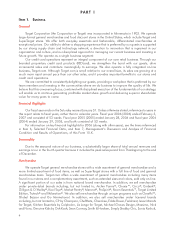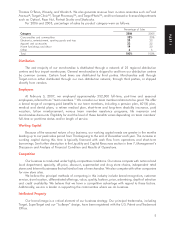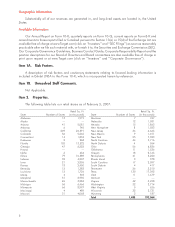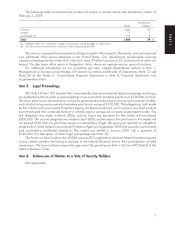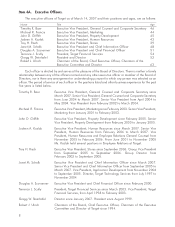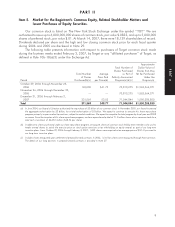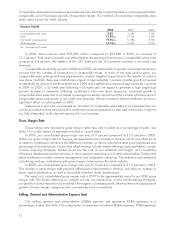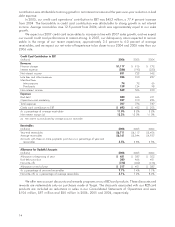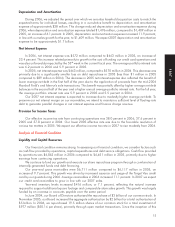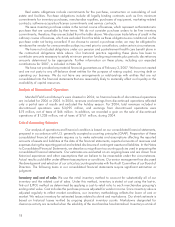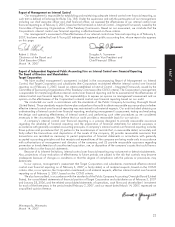Target 2006 Annual Report Download - page 31
Download and view the complete annual report
Please find page 31 of the 2006 Target annual report below. You can navigate through the pages in the report by either clicking on the pages listed below, or by using the keyword search tool below to find specific information within the annual report.
exclude depreciation and amortization, and SG&A expenses also exclude expenses associated with our
credit card operations, which are reflected separately in our Consolidated Statements of Operations.
In 2006, our SG&A expense rate was 22.2 percent compared to 21.8 percent in 2005. This increase
was primarily due to higher store payroll costs, the year-over-year impact of reduced transition services
income related to our 2004 divestiture of Mervyn’s and the $27 million Visa/MasterCard settlement that
reduced SG&A expense in 2005.
In 2005, our consolidated SG&A expense rate was 21.8 percent compared to 21.4 percent in 2004.
The expense rate increase was due to several factors including the year-over-year impact of reduced
transition services income related to our 2004 divestitures of Marshall Field’s and Mervyn’s, higher utilities
expense and the effects of stronger year-over-year performance on incentive and share-based
compensation expense. Some of the expense rate increase was also attributable to growth in marketing
expenses for which the corresponding vendor income is recorded as a reduction of inventory costs because
it did not meet the criteria required for recording it as an element of SG&A expenses. The combination of all
unfavorable expense items more than offset the year-over-year favorability from the $65 million lease
accounting adjustment during 2004.
In 2007, we expect our SG&A expense rate to be approximately equal to our 2006 rate.
Credit Card Contribution
We offer credit to qualified guests through our REDcard products, the Target Visa and the Target Card.
Our credit card program strategically supports our core retail operations and remains an important
contributor to our overall profitability. Our credit card revenues are comprised of finance charges, late fees
and other revenues. In addition, we receive fees from merchants who accept the Target Visa credit card. In
2006, our net credit card revenues primarily increased due to an 11.1 percent increase in average
receivables.
Our credit card operations are allocated a portion of consolidated interest expense based on
estimated funding costs for average net accounts receivable and other financial services assets. Our
allocation methodology assumes that 90 percent of the sum of average net receivables and other financial
services assets are debt-financed with a mix of fixed rate and variable rate debt in proportion to the mix of
fixed and variable rate financial services assets. Beginning in 2005, the majority of our credit card portfolio
began to earn interest at variable rates; thus, the majority of the interest allocation to the credit card business
in 2006 and 2005 is at rates that are determined based upon our approximate marginal variable rate cost
of borrowed funds.
Credit card expenses include a bad debt provision, as well as operations and marketing expenses
supporting our credit card portfolio. In 2006 versus 2005, our bad debt provision decreased relative to our
average receivables balance due to the favorable write-off experience and continued strength of the overall
credit quality of the portfolio. Our 2006 year-end reserve balance as a percentage of average receivables
increased as we reserved for the expected increase in future write-offs. Our delinquency rates increased in
the last quarter of 2006 as compared to 2005 as we cycled the effects of the October 2005 federal
bankruptcy legislation and experience the effects of the mandated increases in minimum payments for
certain guests. Operations and marketing expenses increased primarily due to the growth of the Target Visa
portfolio.
In 2005 versus 2004, our bad debt provision grew at a slower pace than our average receivables
balance due to the aging of the portfolio and the favorable macro-economic credit card environment.
However, our total reserve balance as a percentage of average receivables increased in 2005 as we
reserved for the expected effects of the mandated increases in minimum payments for certain guests. Our
net write-offs as a percentage of average receivables and our delinquency rates continued to improve,
despite a significant increase in bankruptcy filings in advance of the October 2005 effective date of the
related federal bankruptcy legislation. Operations and marketing expenses increased primarily due to the
growth of the Target Visa portfolio.
In 2006, our credit card operations’ contribution to earnings from continuing operations before
income taxes (EBT) was $693 million, a 53.3 percent increase from 2005. The favorability in credit card
13
PART II



